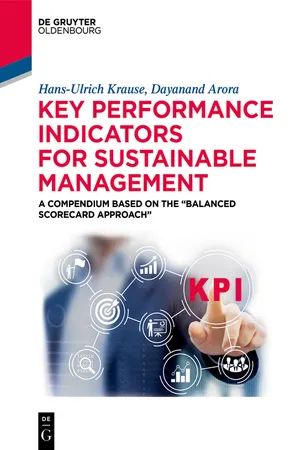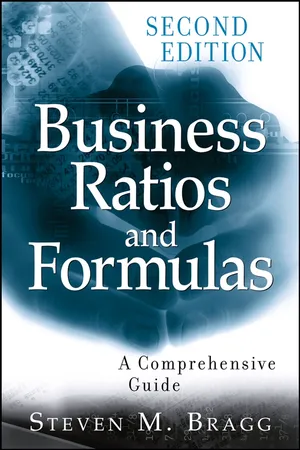Business
Liquidity Ratios
Liquidity ratios are financial metrics used to assess a company's ability to meet its short-term obligations with its current assets. Common liquidity ratios include the current ratio and the quick ratio. These ratios provide insight into a company's short-term financial health and its ability to cover immediate expenses and debts.
Written by Perlego with AI-assistance
Related key terms
Related key terms
1 of 4
Related key terms
1 of 3
10 Key excerpts on "Liquidity Ratios"
- eBook - ePub
- Steven Cohan(Author)
- 2018(Publication Date)
- Routledge(Publisher)
Ratios provide us with a perspective of relationships between two entities. They are found by dividing the magnitude of one entity into the other. We hear and read about ratios every day, particularly in sports. A college basketball point guard who averages twenty shots per game and makes five baskets has a ratio of baskets/attempted shots of 5/20 or 25%. This information assesses the player’s shooting ability, which at 25% would not raise any eyebrows or attract any NBA offers.Financial ratios also provide an index of performance. They indicate how well a business is financially managed. These ratios are calculated from information extrapolated from financial statements. Business ratios are categorized into Liquidity Ratios, debt ratios, activity ratios, productivity ratios, and profitability ratios.Liquidity Ratios
The liquidity status of a company indicates its ability to pay short-term debts with current assets. Liquidity refers to the state of being liquid in terms of cash and assets that can be readily converted into cash. Personal liquidity status would include cash in savings and checking accounts, certificates of deposit, and stocks.Liquidity Ratios measure the current assets of a company against its current liabilities. Current assets are those that can be converted into cash within a twelve-month period. These assets include inventory, accounts receivable, cash, and securities, such as certificates of deposit, money market funds, and stocks. Current liabilities refer to debts that will be paid within a twelve-month period. These liabilities include loan payments, vendor invoices, state and federal taxes, payroll, insurance premiums, leases, and rent.Three primary ratios measure a company’s ability to meet its current financial obligations with its current assets. These ratios are the current ratio, quick ratio, and cash to current liabilities.Current ratio
The amount of current assets and current liabilities is obtained from the company’s balance sheet. Current ratio - eBook - ePub
Excel for Finance and Accounting
Learn how to optimize Excel formulas and functions for financial analysis (English Edition)
- Suraj Kumar Lohani(Author)
- 2023(Publication Date)
- BPB Publications(Publisher)
They are calculated to understand the company’s capability to pay short-term obligations. Liquidity refers to liquidating all current assets to meet all obligations or debt of all current liabilities. Liquidity Ratios are also known as working capital ratios because they define the current (immediate) scenario of the company without raising external capital. It is compared with peer competitors or with the company’s own performance in the previous years. The comparison cannot happen across industries, for example, a coal manufacturing company cannot be compared with a coal trading company.We will study working capital in the next chapter. Three types of Liquidity Ratios are in trend:- Current Ratio
- Quick Ratio
- Cash Ratio
Current Ratio
Current ratio is the major liquidity ratio to analyze the current obligations vs current assets.Where current assets (resources that are consumed or converted into cash within a year) include the following:- Cash and cash equivalents
- Bank deposits
- Marketable securities
- Short-term investments
- Accounts receivable
- Inventory
- Prepaid expenses
- Short-term loans and advances
- Accounts payable
- Short-term loans
- Cash credit and overdraft
- Advance from customers
- Outstanding expenses
- Term loan instalments
- There is high liquidity risk.
- Company might need to raise additional funds via debts or by investment.
- Company is unable to meet its short-term obligations.
- Company can easily meet its short-term obligations.
- Current assets are utilized very well.
- Company’s financial status is good.
The ideal current ratio is 1.33, and a current ratio between 1.33 and 3 is healthy according to investors and lenders. If CR is more than 3, it means current assets are not utilized properly and funds are stuck in inventories or accounts receivables. - No longer available |Learn more
- Stephen L. Nelson(Author)
- 2017(Publication Date)
- For Dummies(Publisher)
Industries commonly prepare reports that summarize financial ratio information for other firms in the industry. Early in my career, I was the controller of an electronics manufacturing firm. Our industry group, the American Electronics Association, prepared a financial ratio survey. With this financial ratio survey, I was able to easily compare the financial ratios of the firm I worked at with the financial ratios of other firms. Currently, as a CPA, I find it very useful that the Texas Society of CPAs and American Institute of Certified Public Accountants prepare an annual financial study that shows financial ratios for CPA firms around the United States. You probably also operate in an industry that has a professional association. Keep your eyes and ears open to the possibility that this group or association prepares and distributes reports that include financial ratios. Such reports can be useful tools for you as you manage your firm.Note:When you compare your firm with other firms by using financial ratios, you compare it with firms of a similar size. It usually doesn’t make sense to compare, for example, a million-dollar business with a billion-dollar business.Some of the QuickBooks financial statements provide simple financial ratios automatically. You can add the gross margin percentage (and other percentage measures) to the standard income statement and to the standard balance sheet, for example.Liquidity Ratios
Liquidity Ratios measure how easily and comfortably a firm can pay its immediate financial obligations and exploit immediate short-term financial opportunities. Everything else being equal, the firm that’s sitting on a large hoard of cash can more easily pay its bills and can take advantage of great opportunities that pop up. (If a competitor gets into trouble and wants to sell valuable assets at fire-sale prices, for example, a very liquid firm with great gobs of cash can more easily exploit such an opportunity.)Current ratio
The current ratio liquidity - eBook - ePub
Key Performance Indicators for Sustainable Management
A Compendium Based on the "Balanced Scorecard Approach"
- Hans-Ulrich Krause, Dayanand Arora(Authors)
- 2019(Publication Date)
- De Gruyter Oldenbourg(Publisher)
Other names for this ratio are: Net Quick Ratio or Acid Test Ratio. The term comes from the way gold miners would test whether their findings were real gold nuggets. Unlike other metals, gold does not corrode in acid; if the nugget didn’t dissolve when submerged in acid, it was said to have passed the acid test. Likewise, if a company’s financial statements pass the figurative acid test, you can use this as an indication that there isn’t any accounting gimmickry going on and that its bank account actually does contain gold!In literature, as also in practice, there are different levels of liquidity. Most common are Level I (Cash Ratio), Level II (Quick Ratio) and Level III (Current Ratio). Whereas in the stringent Cash Ratio, only cash and cash equivalents are included in the numerator, in Current Ratio all current assets (including inventory) are compared with all current liabilities.2.3.3 Current Ratio
Analytical QuestionHow far are short-term liabilities covered by short-term assets?DefinitionThis ratio specifies a percentage rate. The ratio can also be expressed as a multiple of current liabilities, in which case it should not be multiplied by 100.Current Assets ⋅ 100 Current Liabilities Calculation/DerivationThe term “current assets” includes cash at hand, cash at bank, checks, short-term investments, accounts receivable (net of allowance for doubtful debts) and inventory of raw material, work in process and finished products. Assets which have been paid partly by customers, or cannot be sold within a year, should not be included in the list of current assets. The amount of current liabilities is derived from the liabilities side of the balance sheet.Interpretation and Typical RangeThe Current Ratio is part of the account-balance-oriented liquidity analysis, and is considered as an indicator of short-term liquidity. With reference to the closing date, it shows a maturity matching between short-term assets and short-term payment obligations. If the ratio is analysed by external parties, based on annual financial statements, the interpretation may be less meaningful because the relevant position after the financial accounts closing date may have changed significantly.The higher the percentage rate, the more stable the liquidity position of the enterprise. In general, the ideal ratio should give a value equal to 200 % or the so-called 2:1 (A 2:1 current ratio is, sometimes, referred to as “Banker’s rule”.) As a reverse argument, a 2:1 ratio implies that 50 % of the current assets should be financed by long-term liabilities. - eBook - ePub
- Bernard Marr(Author)
- 2015(Publication Date)
- For Dummies(Publisher)
The liquidity KPIs that are most useful are Current Ratio, Quick Ratio, Cash Ratio and Days of Working Capital. These metrics help you to measure how well your business can use its short-term assets to meet its short-term liabilities. Liquidity KPIs help determine business health and offer insight into your exposure to risk and therefore give you the opportunity to reduce that risk if necessary.KPI: Current Ratio
The key performance question that current ratio helps to answer is: ‘Do we have the money to meet our short term obligations?’ This metric measures the amount of current assets you have to pay for every $1 of current liabilities. The data you will need to calculate this KPI is located on the balance sheet.Current Ratio = Current Assets/Current Liabilities Current assets include cash, inventory and accounts receivable. Current liabilities include accounts payable, current debt and tax liabilities. Your company is in good health if your current ratio is 2 or more. This means that you assets are twice as high as your liabilities and you have more than enough assets to pay what you owe.A ratio of 1 or less indicates concern, because your assets are worth either the same or less than your liabilities. This means that you may not be able to pay all your debts. Although not a great sign, it doesn’t automatically spell disaster, but you will need to access more funds or improve efficiency to increase assets.The current ratio will give you a sense of how efficiently your business is run and how easy or otherwise it is to turn your goods and services into cash. Companies that take too long to be paid or have a long lead time for their product can easily run into liquidity problems because they can’t get the money in fast enough to pay their debts.That said, what is perceived as a good or bad current ratio does vary between industries. In order to get a better sense of how acceptable your current ratio really is then compare it to other companies in your sector. - eBook - ePub
Navigating the Business Loan
Guidelines for Financiers, Small-Business Owners, and Entrepreneurs
- Morton Glantz(Author)
- 2014(Publication Date)
- Academic Press(Publisher)
Liquidity Ratios measure the quality and capability of current assets to meet maturing short-term obligations as they come due. Acceptable liquidity levels depend on economic and industry conditions, the predictability of cash flow, and the quality of assets making up Liquidity Ratios.Current Ratio
Defined as current assets/current liabilities, this ratio is a commonly used measure of short-term solvency and debt service. One might surmise that the higher the ratio comparative to industry averages, the better the comfort zone between short-term resources and short-term obligations, but two issues cause this postulation to be incorrect. First, a company blessed with a rapid seasonal conversion cycle usually can get away with a lower current ratio compared to a firm with a sluggish conversion cycle. Secondly, the allocation and quality of key current assets, namely, accounts receivable and inventory, is of great importance in determining acceptable ratio levels. The company’s current ratio at year-end 2014 is shown below.Current ratio = current assets over current liabilities = $240,264/$137,187 = 1.75Current Assets: Cash 11,717 Accounts receivable 88,571 Inventories 139,976 Current assets 240,264 Current liabilities: Short-term loans 55,198 Accounts payable 59,995 Accruals 21,994 Current liabilities 137,187 2012 2013 2014 Industry Average 3.05 2.67 1.75 2.50 The borrower’s current ratio declined over the past 3 years, falling below the industry average. An accounts receivable buildup points to worsening aging, in addition to increased possibilities of bad debt write-offs. Furthermore, inventory has increased. Although some financial writers maintain that “high is best” magnitude means little if receivable and inventory quality fall below acceptable levels.Quick Ratio (Also Known As Acid Test)
The quick ratio is a more conservative measure of liquidity because it measures a firm’s ability to pay off all short-term obligations without relying on the sale of inventory. Since the quick ratio isolates the most liquid assets, it is more accurate than the current ratio. This can be of particular importance if inventory consists of a large portion of current assets. - eBook - ePub
Business Ratios and Formulas
A Comprehensive Guide
- Steven M. Bragg(Author)
- 2010(Publication Date)
- Wiley(Publisher)
Description: If there are cases where the current ratio or quick ratio are not considered to be evidence of a company’s very short-term ability to pay off its liabilities, then the most conservative measure to use is the cash ratio. This ratio uses only cash and short-term marketable securities in the numerator, and so it is the best way to see what proportion of liabilities absolutely, positively can be paid right away. A ratio of 1:1 is reasonable evidence of liquidity.Formula: Add together all cash and short-term marketable securities, and divide the sum by the total of all current liabilities. The formula is:Example: The controller of the Nash Bridge Construction Company has unexpectedly departed. The CFO is concerned that some liabilities may not have been paid on time and orders an immediate calculation of the cash ratio to see if the company has the wherewithal to meet its obligations. The CFO finds that the company has cash on hand of $123,000 and short-term marketable securities of $218,000. Current liabilities are $415,000. The cash ratio is calculated as:With a cash ratio of 82%, the company is close to paying all its cash from cash reserves. The CFO takes immediate steps to create a factoring arrangement with the local bank, in case the company needs to sell off any accounts receivable to meet its obligations.Cautions: There may be cases where some cash cannot be used because of restrictions that are based on loan covenants, compensating balance agreements with banks, or board-mandated restricted funds that can only be tapped to pay for certain types of liabilities. Though rare, one should explore this possibility to ensure that the results of the cash ratio are valid.SALES TO CURRENT ASSETS RATIO
Description: - eBook - ePub
Financial Intelligence for IT Professionals
The Story of the Numbers
- Julie Bonner(Author)
- 2021(Publication Date)
- CRC Press(Publisher)
2The profitability ratios look at a company’s ability to consistently generate or grow its gross margins and net profit margins. You are aware that profit is an estimate, but you know that a business’s operations generate and use cash. Thus, even though you could be looking at estimated numbers and know why they are estimated, you can still see how easily cash is being generated and used in the company.For the solvency ratios, you are looking at the company’s long-term prospects – you will be able to assess if the company maybe exist as a viable company in the foreseeable future. This analysis is an important measure because the calculations include the company’s long-term assets and long-term debt.You will also examine and learn how to use Liquidity Ratios. These ratios tell you how well the company can pay its bills in the short term. These ratios show you the ability to turn current assets into cash to cover those short-term or immediate debts (liabilities).The last category of ratios is the activity ratios. These are another way of looking at cash usage and generation of cash and how well you are managing your working capital. You will assess how well a company manages its cash by how well they manage accounts receivable, accounts payable, and inventory.Finally, you will also do some analysis on free cash flow and how that ties to the earnings before interest, taxes, depreciation, and amortization. It is important to keep it clear in your mind how to handle the non-cash deductions, like depreciation and amortization, and how those are handled when understanding cash flow.Honestly, commit to analyzing these ratios for a company you work for as a baseline of your learning journey. You will start to see just how powerful these numbers are in understanding financial performance. For instance, sometimes, it can be difficult to determine if bad financial decisions are being made. Still, ratios can often point to the possibility that bad financial decisions are being made. - eBook - ePub
Value-Based Working Capital Management
Determining Liquid Asset Levels in Entrepreneurial Environments
- G. Michalski(Author)
- 2014(Publication Date)
- Palgrave Macmillan(Publisher)
The different methods of measuring liquidity can be divided into two groups: static and dynamic. The former are those that use data from the moment at which the level of enterprise liquidity is determined, thus, in principle, from the present and the past. The dynamic methods of measuring, in turn, are based on forecast data (Nowak 1995, pp. 49–53; Sierpinska and Wedzki 1997, pp. 35–36). First, we will deal with so-called traditional measurements of liquidity. They are based on the data received directly from the financial statements, most often from the balance sheet. Such measurements are constructed in such a way as to guarantee independence of the measurement results regardless of the size of the enterprise and can be used for comparing many different types of entities. Therefore, they allow for comparison of the liquidity between enterprises. Their design allows one also to observe changes in liquidity over time in one enterprise even if its dimensions change.Current liquidity ratio is the ratio of current assets to current liabilities (Henderson and Maness 1989, p. 100).where WBP = current ratio, CA = the level of current assets, and CL = the level of current liabilities (obligations due soon).Figure 2.1 and Table 2.1 illustrate the levels of current Liquidity Ratios before (2004−06), during (2007−09), and after (2010–12) the crisis in Czech (CZ), Polish (PL), Slovak (SL), Lithuanian (LT), Latvian (LV), Estonian (EE), Bosnian and Herzegovinian (BA), Hungarian (HU), Ukrainian (UA), Serbian (RS), and Bulgarian (BG) manufacturing enterprises.Figure 2.1 Central European current ratio (WBP) levels before (2003–06), during (2007–09), and after (2010–2012) the crisis in a business environment with continuous growing risk sensitivitySource: Own study based on Database Amadeus product of Bureau van Dijk (date of release: 2013 SEP 10).Table 2.1 Central European current ratio (WBP) levels before (2003–06), during (2007–09), and after(2010–2012) the crisis in a business environment with continuous growing risk sensitivityAs presented in Table 2.1 and Figure 2.1 , the crisis is strongly connected with the average current ratio levels. That observation goes against traditional thinking about liquidity levels that claim that liquidity is smaller during and after a crisis. But this is in accordance with my claim in the previous chapter that growing risk sensitivity forces business managers to collect higher working capital levels to hedge against risk during and after crisis conditions. We also claimed that such a level could be a used as an alarm to warn decision makers about a coming crisis. In the period before a crisis, such current ratio levels start to grow. Such growth accords with the expectation that before the crisis the managers intuitively respond to higher risk sensitivity, making decisions that result in higher levels of both working capital and liquid assets. This is also linked with the intrinsic value of enterprise liquidity - eBook - ePub
- David Worrell(Author)
- 2014(Publication Date)
- Praeger(Publisher)
Remember that each of these ratios—Current, Quick, and Doomsday—are “pure” ratios expressed only as a decimal. And, although the numerator changes, the denominator of each ratio is Current Liabilities. In every case, therefore, a higher number is better than a lower number. If the result of the calculation is greater than 1.0, the company has a pretty good chance of being able to meet its short-term obligations. In some industries, a ratio of 2.0 or greater is expected, particularly in the less stringent measure of the Current Ratio, since it might include inventory (which is notoriously difficult to liquidate). If the result falls below 1.0, the business does not have adequate assets to cover debt and we should consider cutting some debt or going on a strict savings plan.Tip : When evaluating the results of these ratio calculations, keep in mind that today’s Current Liabilities includes only some of what we might owe during the current period (which we previously defined as 12 months). If sales were interrupted for an extended time, new debts would come up, such as continuing payroll and credit card charges. Likewise, we might continue to spend Current Assets (e.g., cash) on expenses like rent. If cash was not replenished by new sales, our ratio results would decline quickly (as would our business in general). So a ratio result of 1.0 from any of these ratios today does not indicate that we could survive the entire current period of 12 months, but only that we could pay off our current debt.These ratios are important, meaningful, and specific. They should not, however, be relied upon without looking at the results from several periods. Fluctuations in bank account balances, inventory levels, and credit card balances (for example) can create large swings in this ratio, particularly for a small business. To overcome this, we measure these ratios on a monthly basis and compare the results. Over time, we may find that the results all fall within a narrow range of values. In this way, we can also set goals for improvement and chart our progress against prior values.
Index pages curate the most relevant extracts from our library of academic textbooks. They’ve been created using an in-house natural language model (NLM), each adding context and meaning to key research topics.
Explore more topic indexes
Explore more topic indexes
1 of 6
Explore more topic indexes
1 of 4









